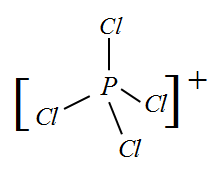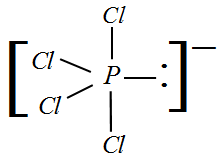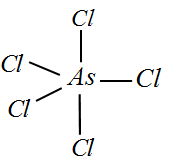
What are the shapes of $PC{l_4}^ + $ , $PC{l_4}^ - $ and $AsC{l_5}$ ?
A. Square planar, tetrahedral and see-saw
B. Tetrahedral, see-saw and trigonal bipyramidal
C. Tetrahedral, square planar and pentagonal bipyramidal
D. Trigonal bipyramidal, tetrahedral and square
Answer
537k+ views
Hint:With the valency of the central atom, find out the hybridization of the molecule. The hybridization of the molecule determines the shape of the molecule. We should also check for the presence of lone pairs and the change in shape due to that.
Complete step-by-step answer:${\rm I})$ $PC{l_4}^ + $ : In this molecule, the valency of central atom Phosphorus is 5 and due to the positive charge one electron is removed. So now the remaining 4 electrons bond with one Chlorine each.

Since there are 4 bonds, the hybridization will be $s{p^3}$ and the shape corresponding to this hybridization is Tetrahedral.
${\rm I}{\rm I})$ $PC{l_4}^ - $ : The valency of Phosphorus is 5 and given a negative charge so now we will have 4 electrons bonded to Chlorine and one lone pair. Hence, the hybridization would be $s{p^3}d$ . Since we have a lone pair, the hybridization changes from $s{p^3}$ to $s{p^3}d$ .

Therefore, for a molecule with a lone pair and $s{p^3}d$ hybridization, the shape would be see-saw.
${\rm I}{\rm I}{\rm I})$ $AsC{l_5}$ : Since Arsenic belongs to the same group as Phosphorus, we can write the valency of Arsenic to be 5. All the 5 electrons are bonded with one Chlorine each and hence we can deduce the hybridization to be $s{p^3}d$ and there are no lone pairs.

Therefore the shape would be trigonal bipyramidal.
Additional information: Hybridization of a molecule plays an important role in determining the shape of that molecule. Presence of a positive or negative charge or a lone pair changes the shape of the molecule.
Note:If the hybridization of the given molecule is $s{p^3}$ then it’s shape would be tetragonal. If the hybridization is $s{p^3}d$ without a lone pair then the shape would be trigonal bipyramidal and with a lone pair the shape would be see-saw.
Complete step-by-step answer:${\rm I})$ $PC{l_4}^ + $ : In this molecule, the valency of central atom Phosphorus is 5 and due to the positive charge one electron is removed. So now the remaining 4 electrons bond with one Chlorine each.

Since there are 4 bonds, the hybridization will be $s{p^3}$ and the shape corresponding to this hybridization is Tetrahedral.
${\rm I}{\rm I})$ $PC{l_4}^ - $ : The valency of Phosphorus is 5 and given a negative charge so now we will have 4 electrons bonded to Chlorine and one lone pair. Hence, the hybridization would be $s{p^3}d$ . Since we have a lone pair, the hybridization changes from $s{p^3}$ to $s{p^3}d$ .

Therefore, for a molecule with a lone pair and $s{p^3}d$ hybridization, the shape would be see-saw.
${\rm I}{\rm I}{\rm I})$ $AsC{l_5}$ : Since Arsenic belongs to the same group as Phosphorus, we can write the valency of Arsenic to be 5. All the 5 electrons are bonded with one Chlorine each and hence we can deduce the hybridization to be $s{p^3}d$ and there are no lone pairs.

Therefore the shape would be trigonal bipyramidal.
Additional information: Hybridization of a molecule plays an important role in determining the shape of that molecule. Presence of a positive or negative charge or a lone pair changes the shape of the molecule.
Note:If the hybridization of the given molecule is $s{p^3}$ then it’s shape would be tetragonal. If the hybridization is $s{p^3}d$ without a lone pair then the shape would be trigonal bipyramidal and with a lone pair the shape would be see-saw.
Recently Updated Pages
Why are manures considered better than fertilizers class 11 biology CBSE

Find the coordinates of the midpoint of the line segment class 11 maths CBSE

Distinguish between static friction limiting friction class 11 physics CBSE

The Chairman of the constituent Assembly was A Jawaharlal class 11 social science CBSE

The first National Commission on Labour NCL submitted class 11 social science CBSE

Number of all subshell of n + l 7 is A 4 B 5 C 6 D class 11 chemistry CBSE

Trending doubts
What is meant by exothermic and endothermic reactions class 11 chemistry CBSE

10 examples of friction in our daily life

One Metric ton is equal to kg A 10000 B 1000 C 100 class 11 physics CBSE

1 Quintal is equal to a 110 kg b 10 kg c 100kg d 1000 class 11 physics CBSE

Difference Between Prokaryotic Cells and Eukaryotic Cells

What are Quantum numbers Explain the quantum number class 11 chemistry CBSE




